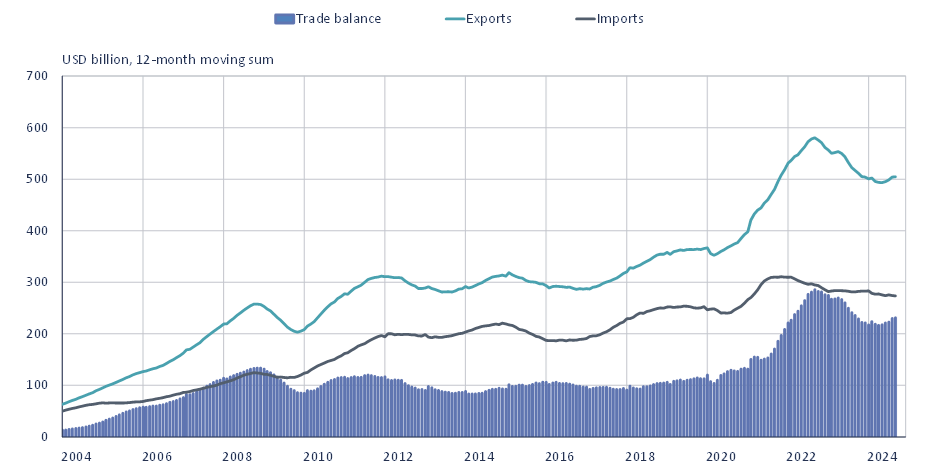BOFIT Weekly Review 42/2024
China faces new challenges in goods trade with the European Union
Foreign trade has lately been an important engine of growth in the Chinese economy. China Customs reports that the dollar-value of Chinese goods exports rose by 3 % y-o-y in the first nine months of this year. The EU remains an important export market for China, accounting for over 13 % of China’s total exports, even if there was virtually no increase in Chinese exports to the EU in the first nine months of this year compared to 2023. The US buys nearly 15 % of China’s total exports, and in the first nine months of this year Chinese goods exports to the US increased by 1 %. One of China’s largest and most dynamic regional export markets is the 10-country Association of Southeast Asian Nations (ASEAN), whose members collectively purchase 16 % of China’s total exports. Growth in Chinese exports to the ASEAN countries has exceeded 7 % y-o-y so far this year.
The value of China’s goods imports rose by 2 % y-o-y in January-September. Imports from Europe, which make up around 10 % of China’s total imports, shrank by 4 % y-o-y, while imports of goods from the US (6 % of total imports) declined by 1 %. Also on the import side, ASEAN countries lead with a 15 % share of China’s total imports. Imports from ASEAN countries increased by 3 % y-o-y in the first nine months of this year.
China’s biggest exports to the EU are telecommunications equipment, electrical machinery and devices, as well as automatic data processing equipment. Meanwhile, automobiles and other vehicles, medicaments, and other machinery are among the largest categories for EU exports to China. The value of China’s exports to the EU over the past twelve months was $505 billion, or nearly double the $274 billion value of China’s imports from the EU, giving China a trade surplus of $231 billion with the EU.
Tense trade relations between the EU and China have created a challenging environment for bilateral trade. On October 4, EU member countries voted in favour of placing import tariffs on Chinese electrical vehicles (EVs). The new tariffs will take effect at the end of October, replacing the temporary tariffs imposed by the European Commission in July. The contentious vote highlighted how divided Europe is on the matter: 10 countries voted for the new tariffs, 12 abstained, and 5 countries, led by Germany, voted against the proposal. The new tariffs, which range from 7.8 % to 35.3 %, are to be imposed on top of the current 10 % tariff. China claims that the EU tariffs violate international trade agreements and has protested the tariffs. It remains to be seen whether the EU and China seek to patch up their trade differences or allow them to further deteriorate.
China’s already-large goods trade surplus with EU27 countries widened during the Covid-19 pandemic

Sources: China Customs, Macrobond and BOFIT.